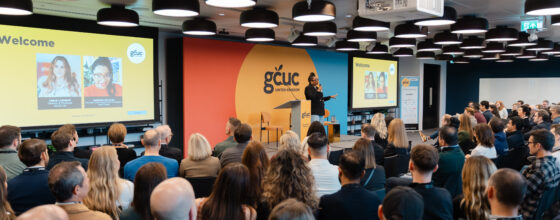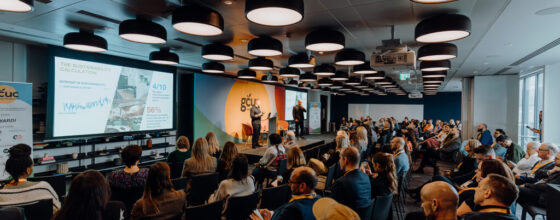16 Takeaways From GCUC Australia

Nearly 200 coworking space operators, community managers, industry consultants, real estate professionals and vendors gathered in Melbourne for two days of tours, expert panels, open forums and happy hours at the Global Coworking Unconference (GCUC AU) on August 24-25.
Conference response was positive and enthusiastic from veterans and newbies alike who came from cities and rural locations in all seven states in Australia, and as far afield as Perth, New Zealand and Tasmania to learn business strategies, share challenges, discover trends, gather information and hoist a pint or two of Juicy Beer.
In the process, ideas and solutions were exchanged, new connections were made, friendships forged and support groups established consistent with the collaborative spirit that is the heart and soul of coworking.
Eye-opening to all
“I thought I knew all about coworking and all the spaces in Australia. I was wrong, reported Simone Eyles,founder, Working Spaces HQ and director at 365cups.com. “GCUC exposed me to how big coworking is and how much bigger it can be. I learned about the impact coworking can have on economic development. It’s not just techies and startups. It’s an opportunity for all pockets of business to start and grow.”
“Being relatively new to the industry (as most people are) I welcomed the opportunity to spend a day away from refilling the coffee machine and printer paper to learn more about industry trends, gain new ideas to improve our space, and of course network with others doing similar types of work,” commented Elise Loterman, community development manager at deskworxx.
Key takeaways:
- The coworking community Down Under is as vibrant, professional and generous as it is in the U.S. “The energy, vibe and ‘collaborativeness’ is global,” reported Steve Golding, founder, Meeting Hub. “The consensus from those who attended NY and LA was that the same level of professionalism exists globally within this industry. It’s the same exceptional ‘Can do.’ ‘Will do,’ ‘How do I help?’ ‘How do I share experience?’”
- Coworking spaces are increasing productivity. This is largely due to some of the extra touches that coworking space operators and managers add to the experience such as free food and opportunities for social interaction. These encourage people to enjoy their work environment and therefore increase their productivity.
- The coworking industry is becoming more corporate. It is no longer a movement just for freelancers and digital nomads but a new way of working that is being embraced by corporate companies.This model will continue to expand with companies seeking to retain their talent by understanding the importance of maintaining a flexible and innovative work environment.
Additionally, commercial landlords are going to need to understand the benefits that coworking spaces can bring to their buildings and learn to embrace the flexibility and adaptability that comes with that.
- Local coworking operators will need to be more innovative and think more creatively about bringing in new streams of income to remain viable as international companies enter the market and increase competition. One suggestion was to develop strategic relationships with other coworking spaces to strengthen the overall ecosystem and presence of local businesses.
Carl Sullivan, Your Desk, provided ideas and strategies to generate leads and revenue, including offering an iPad sign in for WiFi to convert random visitors into champions and members of the space, providing secretarial services and hosting events and to engage the local community.
- Coworking’s cooperative focus differentiates it from the business center community. “If I was to use a term that defines GCUC I think it would be supportive and safe,” offered Golding, in contrast to the property-focused business center community. ”You just wouldn’t get the same degree of collaboration, openness and desire to help each other that you do in coworking.”
“Even coworking spaces located one block from each other are willing to share what works and what doesn’t. You don’t get that in business centers,” he added.
And thats not even all of it. To read the rest of the juicy goodness, head on over here.









